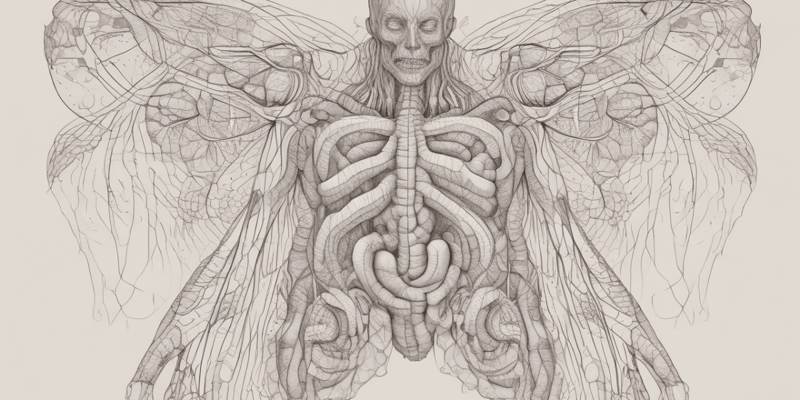Questions and Answers
What is the main function of epithelial tissue?
What determines the function and characteristic of connective tissue?
What is the non-cellular component of a connective tissue between the cells and fibres?
What is the function of ground substance in connective tissue?
Signup and view all the answers
What is the characteristic of pseudostratified epithelial tissue?
Signup and view all the answers
What is the characteristic of stratified epithelial tissue?
Signup and view all the answers
What is the function of ciliated epithelial tissue?
Signup and view all the answers
What is the characteristic of glandular epithelial tissue?
Signup and view all the answers
What type of connective tissue is blood and lymph considered as?
Signup and view all the answers
What is the main function of skeletal muscles?
Signup and view all the answers
What is characteristic of smooth muscle cells?
Signup and view all the answers
Which type of muscle tissue is found in the walls of the stomach and intestines?
Signup and view all the answers
What is the characteristic of cardiac muscle cells?
Signup and view all the answers
What is the control type of skeletal muscles?
Signup and view all the answers
What is the main difference between skeletal and smooth muscle cells?
Signup and view all the answers
What is the function of plasma in the body?
Signup and view all the answers
What is one of the primary functions of adipose tissue?
Signup and view all the answers
Which type of dense connective tissue is known for withstanding a lot of stress due to its parallel bundles of collagen?
Signup and view all the answers
What type of cartilage provides a framework and is found at the ends of bones and in the nose?
Signup and view all the answers
Which connective tissue is characterized by a viscous ground substance and is highly vascularized?
Signup and view all the answers
What is a key characteristic of fibrocartilage?
Signup and view all the answers
What role do connective tissues play in relation to organs?
Signup and view all the answers
Which connective tissue is important for maintaining the structure of arteries and providing elasticity?
Signup and view all the answers
What is a common function of both ligaments and tendons?
Signup and view all the answers
What is the smallest part of the skeletal muscle?
Signup and view all the answers
What are myofibrils primarily composed of?
Signup and view all the answers
Which neurotransmitter is responsible for muscle movement?
Signup and view all the answers
How does the brain communicate with muscles to induce movement?
Signup and view all the answers
What structure is formed by the arrangement of many muscle fibers?
Signup and view all the answers
What role do motor neurons play in muscle movement?
Signup and view all the answers
What happens at the synapse to facilitate muscle movement?
Signup and view all the answers
In what order do the components of skeletal muscles increase in size?
Signup and view all the answers
Study Notes
Tissues Overview
- Tissues are groups of cells with similar functions.
- Four main types: epithelial, connective, muscle, and nervous tissue.
Epithelial Tissue
- Composed of closely packed cells covering surfaces and lining organs.
- Functions include protection and enabling fluid and gas exchange.
- Types are classified by layers and cell shapes:
- Layers: simple (single), stratified (multiple), pseudostratified (appears multiple).
- Shapes: squamous (flat), cuboidal (cube-like), columnar (tall).
- Additional characteristics: ciliated (hair-like), transitional (varied shapes), glandular (secretory).
Connective Tissue
- Composed of cells, protein fibers, and ground substance (extracellular matrix).
- Ground substance varies: viscous (blood), semisolid (cartilage), solid (bone).
- Functions include:
- Enclosing and separating organs.
- Connecting tissues (ligaments, tendons).
- Supporting and moving (cartilage, joints).
- Storing (adipose tissue, bones).
- Cushioning and insulating (adipose).
- Transporting and protecting (blood).
Types of Connective Tissue
-
Loose Connective Tissue:
- Areolar: viscous ground substance, collagen and elastin fibers, vascularized, found around organs and blood vessels.
- Adipose: closely packed fat cells, found under the skin, provides insulation.
-
Dense Connective Tissue:
- Regular: parallel collagen bundles, withstands stress, forms tendons and ligaments.
- Irregular: nonlinear collagen pattern, found in skin and bone coverings, withstands stress.
- Elastic: dense elastic fibers, found in trachea, maintains elasticity.
-
Supportive Connective Tissue:
- Cartilage: strong and flexible, high collagen content, types include:
- Hyaline: framework, found at bone ends and nose.
- Fibrocartilage: compression resistance, found in spinal column and knee.
- Elastic: flexible framework, found in the ear and larynx.
- Cartilage: strong and flexible, high collagen content, types include:
-
Bone: composed of collagen fibers in hard mineral substances (calcium, magnesium, phosphate), forming compact and spongy types.
-
Fluid Connective Tissue:
- Blood and lymph: liquid with a fluid extracellular matrix (plasma), transports nutrients.
Muscle Tissue
- Abundant tissue made of muscle fibers with striations.
- Three types:
- Skeletal Muscle: voluntary movement, cylindrical, multinucleated, striated.
- Cardiac Muscle: involuntary contraction of the heart, short, branching, single nucleus, faintly striated with intercalated disks.
- Smooth Muscle: involuntary, no striations, spindle-shaped, single nucleus, found in organs and blood vessels.
Organization and Function of Skeletal Muscles
- Skeletal muscles are arranged in bundles (fascicles) of fibers.
- Fibers are made of myofibrils, which consist of myofilaments (actin and myosin).
- Functionality based on brain signals:
- Brain initiates movement by sending signals via motor neurons.
- Neurotransmitters (specifically acetylcholine) enable muscle contraction.
Muscle Control
- Muscle movement begins with a brain decision, followed by neural signals transmitted to muscles.
- The synapse is where neurotransmitter ACh is released to facilitate muscle contraction.
Studying That Suits You
Use AI to generate personalized quizzes and flashcards to suit your learning preferences.
Description
Understand the different types of body tissues, including epithelial, connective, muscles, and nervous tissues. Learn about their functions and characteristics in this biology quiz.



